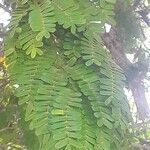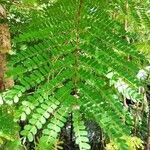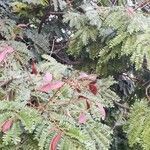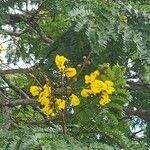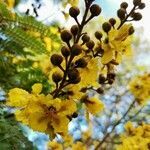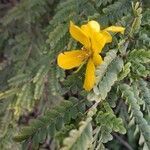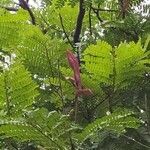Trees, 4-15 m tall. Young shoots, petioles, and inflorescences ferruginous hairy; old branches with yellowish, small lenticels. Leaves 30-42 cm; petiole robust; rachis 25-35 cm; pinnae 7-15 pairs, opposite, 8-12 cm; leaflets (7-)10-21 pairs, crowded together, oblong-obovate, 1.2-1.7 cm × 5-7 mm, leathery, abaxially pale green, adaxially deep green, base oblique, margin entire, apex rounded, mucronate. Panicles terminal or axillary, densely ferruginous puberulent; bracts caducous, 5-8 mm. Pedicels ca. 5 mm, ca. as long as flower buds, 5-7 mm from one another. Flower buds globose, 5-8 mm in diam. Sepals ovate, 5-8 × 4-7 mm, outside ferruginous tomentose. Petals obovate, 1.5-1.7 cm × 8-10 mm, densely ferruginous pubescent at middle of both surfaces, long clawed. Filaments ca. 1.2 cm, hirsute at base; anthers ca. 3 mm, sagittate at base. Ovary stalked, hairy, 3-or 4-ovuled; style filiform, much longer than ovary, smooth; stigma discoid, 3-lobed. Legume winged, compressed, fusiform, narrowed to both ends, longitudinally veined at middle part; wings 4-5 mm wide. Seeds 2-4. 2n = 26.
Tree to 15 m high; branchlets rusty-pubescent. Leaves rusty-pubescent when young; stipules simple, inconspicuous; petioles mostly 3–7.5 cm long; rachis mostly 10–30 cm long; pinnae 5–14 pairs; secondary rachises mostly 4–13 cm long; leaflets usually 9–20 pairs per pinna, oblong or oblong-rhombic, 8–21 mm long, 3.5–10 mm wide, asymmetric basally, rounded and usually emarginate apically, glabrous or appressed-pubescent. Racemes aggregated into terminal panicles, erect; axis densely rusty-pubescent. Flowers on rusty-pubescent pedicels 4–10 mm long. Calyx rusty-pubescent; lobes 5–10 mm long. Petals 1.3–2.3 cm long, yellow, rusty-hirsute basally within. Ovary rusty-pubescent. Pod 5–10 cm long, 2–3.2 cm wide, longitudinally striate, eventually splitting lengthwise along the middle of the valves. Seeds elliptic, 10–11 mm long, 5–5.5 mm wide.
A tree that loses its leaves. It grows 15-25 m tall. The trunk is 1 m across. The leaves are 30-60 cm long and twice divided. There are 16-20 pinnae and each on has 20-40 oval leaflets. These are 5-25 mm long and 4-10 mm wide. The flowers are yellow and 3-4 cm across. They are in large compound groups 20 cm long. The fruit is a pod 5-10 cm long and 2.5 cm wide. It is red when young but turns black. It contains 4 seeds.
Leaves: petiole and rachis together up to 35 cm, brown-tomentose when young; pinnae 7–14 pairs; pinna rachis 4–13 cm; leaflets (5)9–17(20) pairs per pinna, (5)8–21 × (2)4–8(9) mm, ± oblong or oblong-rhombic, very asymmetrical at the base, rounded and usually emarginate (never mucronate) at the apex; both surfaces pubescent to glabrous; stipules simple and inconspicuous or apparently absent.
With 10–19 pairs of leaflets per pinna which are emarginate and without a mucro at apex and ± 0.8–3 cm. long and 0.35-0.9 cm. wide, small unbranched stipules, racemes aggregated into a terminal panicle, and pedicels at flowering time at most as long as the calyx.
Inflorescence like that of P. africanum but usually longer and with more branches; pedicels 4–7(10 in fruit) mm, approximately as long as the calyx.
Pods (4)5–12 × 1.6–3.2 cm, narrowly elliptic to oblong; seeds 1–3(?4).
Young stems shortly brown-tomentose, glabrescent.
Sepals (5)6–8(10) mm long.
Ovary as in P. africanum.
Petals 13–23 mm long.
Tree up to 17 m high.
